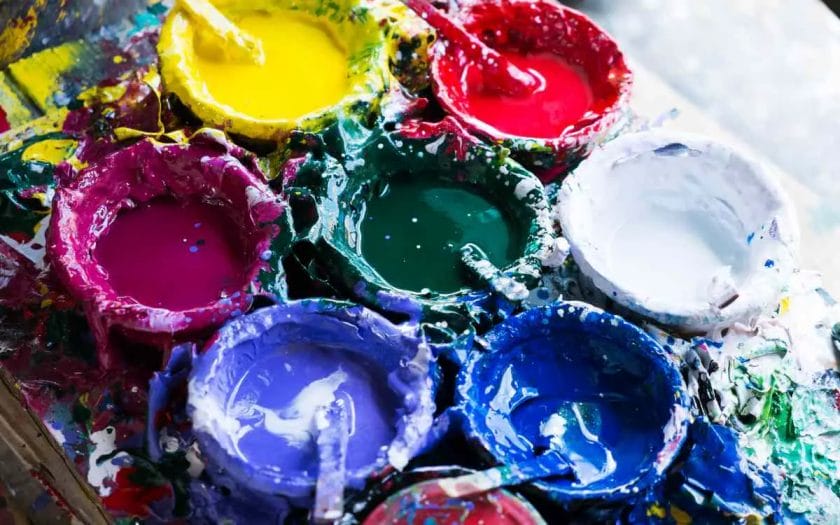Due to their nature and composition, acrylic paints are fast-drying, and once they dry, they become rigid, plasticized, and water-resistant.
If you’re experiencing something similar with your acrylic paint, here are some tips on how to soften it up:

Use Warm Water
Since acrylic paints are usually water soluble until they get dry and hardened, it’s possible to soften hard acrylic paint using warm water. Cool water may not do the magic but warm water should be able to penetrate and break the bond.
All you need to do is to add some warm water to the hard acrylic paint and crush it into chunks using a palette knife. Allow the mixture to sit for some minutes so that the warm water can penetrate the solid paint.
Crush the hard acrylic paint again and then stir the mixture gently until the acrylic paint becomes gelatinous. Add more warm water and continue stirring until you achieve a smooth consistency.
Please note that this method is not suitable if your acrylic paint is completely dried out and has become hardened. If this is your case, try the subsequent methods.
Use Alcohol
For this method, I’ll recommend that you use denatured alcohol and not rubbing alcohol. Denatured alcohol doesn’t contain water, it also contains powerful solvents like ethyl alcohol (ethanol) and methyl alcohol (methanol). All these make denatured alcohol stronger and more effective than rubbing alcohol.
Pour some amount of denatured alcohol on the dry acrylic paint and slightly crush the paint with a palette knife. Leave the mixture for some hours to allow the alcohol to work on the hardened acrylic paint. Slightly crush the paint again until it’s completely softened.
When working with denatured alcohol, you should always be cautious. Denatured alcohol is highly inflammable and also contains methyl alcohol, which is poisonous. For your safety, use denatured alcohol only in a well-ventilated area, and don’t get close to a heat source or fire when using it.

Use Acetone
Acetone is a powerful solvent and a sure bet to soften hard acrylic paint. It will react with the hard acrylic paint to break it down within a few minutes. Here’s how to soften your hard acrylic paint using acetone:
Add a part of acetone to three parts of the hard acrylic paint – this is the recommended proportion for softening hard acrylic paint. Adding excess acetone beyond this recommended proportion will completely dissolve the acrylic paint and the paint won’t dry or thicken again.
Stir/shake the mixture together and leave it for a while. The hard acrylic paint should gradually soften into the initial moderately–thick liquid paint.
Stir at an interval to ensure that the acetone and acrylic paint mix together thoroughly. Otherwise, a part of the acrylic paint will appear thinner than the other.
Please note that though acetone is low in toxicity, it’s highly inflammable. So, be careful when handling acetone. Also, you shouldn’t use acetone on synthetic fabrics or plastics – don’t use acetone on dry acrylic paint in plastic containers.
Use Acrylic Flow Improver
Acrylic flow improver is also a solvent that can soften hard acrylic paint. It works by restoring the hard acrylic paint back to its usual viscosity. Softening your acrylic paints with an acrylic flow improver follows an easy process.
Acrylic flow improver is to acrylic paint as water is to watercolor. So, you can add as much acrylic flow improver to your hard acrylic paint to revamp it.
After adding the flow improver, stir the mixture gently using a palette knife or any other suitable material. Also, add some water to the mixture and stir until you achieve your desired viscosity. The acrylic flow improver will keep your acrylic paint at this desired viscosity for a while after.
Use Lacquer Thinner
Similar to acetone, lacquer thinner is a stronger solvent and should also soften your hard acrylic paint. Softening your hard acrylic paint using lacquer thinner follows the same procedures as using acetone.
Unfortunately, lacquer thinner is toxic. It contains some chemical compositions that are harmful to health. If you need to use lacquer thinner, I’ll recommend that you use it outdoors.
If none of the methods above softens your hard acrylic paint, that means the dry acrylic paint has turned into hard plastic and it’s irredeemable. At this point, you’ve got to give up on the hardened paint, throw it away, and buy a replacement acrylic paint.
To prevent your acrylic paint from drying for as long as possible, always do the following:
- Use a stay-wet palette. If you use acrylic paints oftentimes, invest in a stay-wet palette. A stay-wet palette will keep your acrylic paint moistened.
- Always cap the jar or tube of acrylic paints immediately after dipping the paintbrush. Don’t expose the paint for too long even during use.
- Keep your acrylic paints in a cool place. Make sure that your workspace is properly covered and if you need to paint outdoors, keep the acrylic paints away from sunlight and open air.
To Summarize
Dry acrylic paint can be frustrating, but you can easily revive your hard acrylic paints using some simple methods. You can use acetone, lacquer thinner, or an acrylic flow improver to soften the dry acrylic paint.
If none of these methods works, then you’ve got to discard the hardened paint and buy a replacement one.
